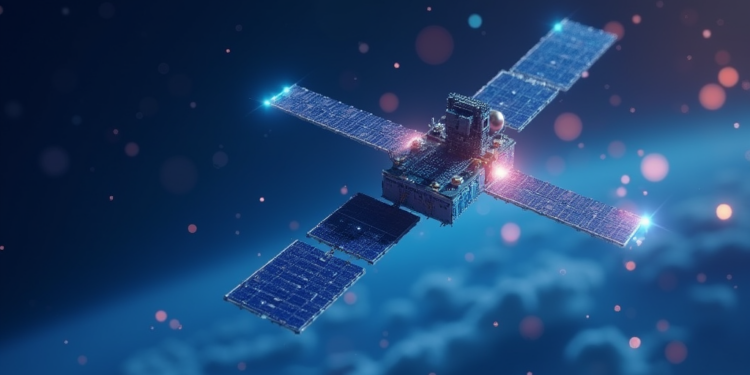The Bluetooth Satellite Startup, Bluelink Satcom, is making waves in the realm of Chinese satellite technology with its innovative approach to satellite networks. Recently raising tens of millions of yuan in early-stage funding, this pioneering company aims to revolutionize IoT connectivity by leveraging Bluetooth technology in space. Bluelink Satcom’s ambitious plans include launching satellites that can detect Bluetooth signals from hundreds of kilometers away, marking a significant leap forward for low-power, high-coverage data transmission. Supported by investors like LinGe Ventures, the startup is set to develop a system that simplifies connectivity, allowing countless Bluetooth devices to communicate effectively without the need for complex hardware modifications. With a vision to enhance infrastructure in remote areas, Bluelink Satcom underscores the potential of satellite funding in transforming the future of global communication technologies.
Introducing Bluelink Satcom, the innovative venture at the forefront of the emerging Bluetooth satellite landscape, a concept that could redefine global communication. This startup’s strategic focus on satellite technology aims to bridge gaps in IoT connectivity, particularly where traditional networks falter. By utilizing advanced Bluetooth technology in space, they plan to deploy a network of satellites that will facilitate mass data transmission from devices operating in remote environments. Their recent funding achievement signals a robust commitment to enhancing low-cost communication solutions through satellite development. Bluelink Satcom reflects a growing trend in the commercial aerospace sector, resonating with government support for technological advancements in China.
The Impact of Chinese Satellite Technology on IoT Connectivity
Chinese satellite technology plays a critical role in the advancement of Internet of Things (IoT) connectivity on a global scale. By leveraging advanced satellite systems, particularly those developed by startups like Bluelink Satcom, regions that previously lacked reliable internet access can now benefit from this innovative approach. The deployment of low-cost satellite networks can help connect numerous IoT devices, which can range from simple sensors to complex monitoring systems, effectively bridging the gap between technological infrastructure and isolated areas. This is particularly important in rural or remote regions where traditional connectivity solutions like cellular networks may be unreliable or non-existent.
The potential implications of this technology are vast. For instance, in addition to providing connectivity for agriculture and environmental monitoring, the integration of IoT with satellite systems could enhance emergency response operations. By enabling real-time data updates from sensors located in remote locations, authorities can ensure timely and efficient disaster management and recovery efforts. Thus, the improvements in satellite technology will not only revolutionize IoT connectivity but also provide new capabilities for monitoring and responding to real-world problems.
Bluelink Satcom: Pioneering Bluetooth Technology in Space
Bluelink Satcom’s innovative approach of adapting Bluetooth technology for satellite deployment sets it apart in the expanding satellite communication landscape. By utilizing Bluetooth signals received from devices on the ground, the startup aims to create a network of satellites that can extend the reach of IoT devices into areas traditionally out of bounds. This method is not only relatively cost-effective compared to current communication satellites but also leverages the widespread adoption of Bluetooth technology across various industries, from healthcare to logistics. As a result, Bluelink is opening doors to a new era of connectivity that aligns with the needs of the expanding IoT ecosystem.
Moreover, by integrating Bluetooth with satellite technology, Bluelink can enhance data transmission capabilities while minimizing the energy requirements typically associated with satellite communications. This adaptation allows devices to send low-power signals to satellites without requiring significant hardware modifications, fostering seamless upgrades for existing Bluetooth-enabled devices. This positions Bluelink Satcom at the forefront of innovation, as it looks to launch its first payload and demonstrate the viability of this technology in orbit within the coming months.
Funding and Future Prospects for Bluelink Satcom
The recent funding secured by Bluelink Satcom highlights the growing interest and investment in satellite technology within China. With an infusion of tens of millions of yuan, the company is poised to further develop its pioneering solutions and establish a strong presence in the satellite communications market. The backing from notable venture capital firms such as LinGe Ventures and Hongfu Capital underscores the confidence in Bluelink’s business model, as well as the strategic importance of enhancing IoT connectivity through innovative satellite systems.
Looking ahead, Bluelink Satcom has ambitious plans to establish a network of 72 satellites by 2028, aiming to provide continuous coverage and improve revisit times for data collection. As government support in China accelerates the growth of commercial space ventures, Bluelink is ideally positioned to capitalize on this momentum. The company not only faces competition from startups like Hubble Network but also can innovate rapidly, thanks to its integration with China’s robust Bluetooth ecosystem. This competitive edge could enable Bluelink to scale quickly and meet evolving market demands.
Understanding Satellite Funding in the Modern Era
Satellite funding has become increasingly vital as the commercial space sector evolves. With startups like Bluelink Satcom garnering attention, investors are recognizing the potential for satellite networks to address critical connectivity gaps. Globally, there has been an influx of funding aimed at leveraging satellite technology for various applications, including IoT connectivity, communications, and earth observation. This trend highlights the growing realization that satellite infrastructure can provide solutions to challenges posed by traditional connectivity methods.
In China, the government’s support for satellite funding has catalyzed the development of numerous space-focused startups. As regions push to integrate technology into their infrastructures, funding opportunities are abundant, driving innovation in wireless communication solutions. Companies can tap into these resources to explore diversified applications, ultimately leading to breakthroughs that redefine access to information and connectivity across sectors. This foundational financial support enables firms like Bluelink Satcom to thrive while creating a competitive landscape for optimizing satellite technologies.
The Role of Bluetooth Technology in Space Communications
Bluetooth technology has revolutionized the way devices communicate over short distances, and Bluelink Satcom aims to take this innovation further by adapting it for satellite communications. By enabling Bluetooth devices to send signals to satellites, users can access data and services even in environments devoid of conventional connectivity. This technological advancement not only makes data transmission more accessible but also highlights the unique capabilities of low-power Bluetooth in facilitating communication across vast distances—essential in remote and underserved areas.
By deploying this Bluetooth-satellite connection model, Bluelink Satcom can significantly lower the infrastructure demands traditionally associated with satellite communication. The ability to operate using low-power signals means that satellite systems can effectively cover broader areas without extensive energy consumption, making this solution viable for scaling up IoT applications. Therefore, the integration of Bluetooth technology into satellite communications represents a pivotal step toward optimizing data exchange in both urban and rural contexts.
Strategic Advantages of Bluelink Satcom’s Technology
Bluelink Satcom’s approach to satellite technology presents strategic advantages that can reshape the landscape of IoT connectivity. Their system allows for cost-effective solutions tailored for specific use cases, such as meteorological monitoring and resource management. By focusing on one-way communication from Bluetooth devices to satellites, Bluelink can simplify the infrastructure required for data transmission, making it suitable for an array of applications, particularly in sectors where monitoring and data collection have historically relied on costly manual processes.
Furthermore, Bluelink’s technology offers significant flexibility, as devices can connect without needing major hardware changes. This ease of integration is a game-changer for device manufacturers, encouraging them to adopt the technology for their products without incurring substantial additional costs. As a result, this could accelerate the growth and adoption of IoT solutions across various industries while improving overall efficiency in data communication processes, solidifying Bluelink’s competitive edge in the satellite technology market.
Challenges Facing the Satellite Communication Industry
While the rise of satellite communication technologies offers exciting prospects, it also brings a set of challenges that companies like Bluelink Satcom must navigate. One of the primary concerns is market competition. With multiple companies vying for dominance in the satellite IoT space, differentiating their offerings will be essential for success. Moreover, as demand surges, the need for regulatory compliance and spectrum management becomes critical in ensuring that operations can scale without interference or operational hiccups.
Additionally, the implementation of new technologies can often be met with skepticism from potential clients accustomed to relying on established systems. Bluelink will need to demonstrate the reliability and efficacy of its Bluetooth satellite solution to ensure acceptance among its target market. The challenge lies in building trust and proving the advantages of their approach compared to conventional communication methods, especially in sectors where real-time data is paramount.
Future Trends in Satellite Networks and Bluetooth Integration
The integration of Bluetooth technology within satellite networks marks a significant trend that can redefine the future of communication systems. As demand for more efficient data transmission methods rises, companies will increasingly look to leverage innovative combinations of technologies that include Bluetooth and satellite capabilities. This integration not only enhances the performance of IoT devices but also expands the potential applications across sectors ranging from logistics to environmental monitoring.
As more companies explore the possibilities of this technology, we can anticipate a trend toward collaborative developments within the satellite community. Partnerships may emerge between entities focused on different aspects of satellite and IoT integration, facilitating the exchange of expertise and resources. Industry leaders like Bluelink Satcom stand to benefit from these trends by adopting agile strategies that respond to evolving market needs, ensuring they play a key role in shaping the future landscape of satellite technology.
Frequently Asked Questions
What is the role of Bluetooth technology in the Bluelink Satcom satellite network?
Bluelink Satcom leverages Bluetooth technology to offer IoT connectivity from space, allowing devices to transmit data to satellites via low-power Bluetooth signals. This innovative approach enables communication in areas where conventional networks are absent, marking a significant advancement in satellite technology.
How does Bluelink Satcom’s Bluetooth Satellite Startup differ from traditional satellites?
Bluelink Satcom’s Bluetooth Satellite Startup focuses on detecting Bluetooth signals from devices instead of relying on traditional satellite communication methods. Their satellite network is designed for one-way data transmission, making it a cost-effective solution for low-speed IoT connectivity without the need for hardware changes on existing devices.
What recent funding round did Bluelink Satcom complete for their Bluetooth satellite project?
On March 25, 2024, Bluelink Satcom announced an angel+ funding round where they raised between $3 million and $13 million. This funding is specifically aimed at constructing China’s first Bluetooth satellite network, enhancing their capabilities in satellite funding and technology development.
What potential applications do Bluelink Satcom’s Bluetooth satellites target?
Bluelink Satcom’s Bluetooth satellites are expected to target applications such as meteorological emergencies, traffic management, and the structural monitoring of infrastructures like bridges and buildings. This focus highlights the adaptive usage of Chinese satellite technology for efficient data collection in remote areas.
How soon does Bluelink Satcom plan to launch its Bluetooth satellites?
Bluelink Satcom intends to launch its first Bluetooth satellite payload into orbit by late Q2 or early Q3 of 2024. By the end of 2025, they aim to have a total of four payloads in orbit for verification, expanding their satellite network significantly by 2028.
What advantages does Bluelink Satcom claim for its Bluetooth satellite technology?
Bluelink Satcom claims that its technology provides substantial advantages, including low-power signal transmission, which minimizes energy and infrastructure demands. This capability enhances IoT connectivity significantly, facilitating data communication from remote locations without requiring expensive hardware modifications.
How does the Bluetooth technology in space from Bluelink Satcom compare to existing IoT satellite providers?
Unlike existing IoT satellite providers that often require proprietary hardware, Bluelink Satcom’s Bluetooth satellite solution merely requires a Bluetooth software update for devices. This provides a unique market advantage in terms of scalability and integration with existing Bluetooth ecosystems.
Who are the primary competitors of Bluelink Satcom in the Bluetooth satellite industry?
Bluelink Satcom’s primary competitor in the Bluetooth satellite industry is Seattle-based Hubble Network, which plans a larger constellation of satellites for global IoT coverage. Bluelink Satcom believes its deep integration within China’s Bluetooth ecosystem positions it favorably in the competitive landscape.
What is the strategic vision of Bluelink Satcom for its Bluetooth satellite network by 2028?
Bluelink Satcom aims to have 72 Bluetooth satellites in orbit by the end of 2028, enabling efficient IoT connectivity with revisit times of mere minutes. Their strategic vision is to provide extensive coverage and enhance the monitoring capabilities for devices that operate primarily on Bluetooth technology.
| Key Points | Details |
|---|---|
| Startup Name | Bluelink Satcom (Beijing Lanying Xingtong Technology Co., Ltd) |
| Funding Raised | Early-stage funding of tens of millions of yuan (approximately $3M to $13M) |
| Funding Purpose | To develop China’s first Bluetooth satellite network for low-speed IoT connectivity |
| Technology | Uses Bluetooth to transmit data from devices to satellites |
| Unique Feature | One-way communication only; satellites do not send data back to devices |
| Initial Applications | Meteorological emergencies, traffic management, structural monitoring |
| Deployment Plans | Launch first satellite by Q2/Q3 2024, with a total of 72 satellites planned by 2028 |
| Competition | Only other competitor is Seattle-based Hubble Network focusing on satellite constellations |
| Government Support | Backed by China’s government initiatives to enhance the commercial space sector |
Summary
The Bluetooth Satellite Startup, Bluelink Satcom, has taken a significant step in revolutionizing Internet of Things (IoT) connectivity with its innovative satellite technology. By securing substantial funding and developing China’s first satellite capable of detecting Bluetooth signals from space, the company aims to provide low-cost, wide-area IoT solutions. This pioneering initiative is set to enhance data collection capabilities in remote locations, making it beneficial for various applications such as monitoring of infrastructure and traffic management. With the support of the Chinese government, Bluelink Satcom is poised to compete in the high-potential satellite IoT market, showing promise for future advancements.












